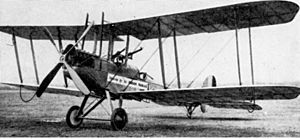No. 17 Squadron RAF facts for kids
Quick facts for kids No. XVII Squadron RAF |
|
|---|---|
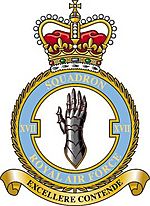
Squadron badge
|
|
| Active | 1 February 1915 – 1 April 1918 (RFC) 1 April 1918 – 14 November 1919 (RAF) 1 April 1924 – 23 February 1948 11 February 1949 – 13 March 1951 1 June 1956 – 31 December 1969 1 September 1970 – 31 March 1999 1 September 2002 – 12 April 2013 12 April 2013 – present |
| Country | |
| Branch | |
| Type | Flying squadron |
| Role | Test and evaluation |
| Home station | Edwards AFB, California |
| Motto(s) | Excellere Contende (Latin for 'Strive to excel') |
| Aircraft | Lockheed Martin F-35B Lightning |
| Battle honours | * Honours marked with an asterisk may be emblazoned on the Squadron Standard |
| Insignia | |
| Squadron badge heraldry | A Gauntlet symbolizing armed strength and previous operation of the Gloster Gauntlet fighter in the 1930s. Approved by Edward VIII in October 1936. |
| Squadron roundel |  |
| Squadron Codes | UV Nov 1938 – Sep 1939 YB Sep 1939 – Feb 1948 UT Feb 1949 – Mar 1951 B (Carried on Jaguars) CA–CZ Aug 1985 – Mar 1999 |
Number 17 Squadron, also known as No. 17 Test and Evaluation Squadron, is a special flying unit of the Royal Air Force (RAF). It was restarted on April 12, 2013, at Edwards Air Force Base in California. Its main job is to test and evaluate the new Lockheed Martin F-35B Lightning aircraft.
Contents
History
First World War
No. 17 Squadron first formed on February 1, 1915, at Gosport. It was part of the Royal Flying Corps (RFC). The squadron first used the Royal Aircraft Factory B.E.2c plane. After training, the squadron went to Egypt in November 1915.
On December 24, they flew their first mission over Turkish lines in Sinai. They also helped ground troops in the Western Desert. In July 1916, the squadron moved to Salonika. It was the only RFC unit in Macedonia for a while. They mostly flew reconnaissance missions and helped direct artillery fire near the Bulgarian border.
Between the World Wars
After the First World War, the squadron was disbanded on November 14, 1919. It reformed on April 1, 1924, at RAF Hawkinge. At this time, No. 17 Squadron helped defend the UK with fighter planes.
In June 1927, a pilot named Charles Lindbergh borrowed a plane from the squadron. He flew it from London to Paris after his famous flight across the Atlantic Ocean. The squadron used many different types of planes during these years. These included the Hawker Woodcock, Gloster Gamecock, and Armstrong Whitworth Siskin.

In October 1929, they started using Bristol Bulldog Mk.IIs. In 1935, during a crisis, they had to send most of their Bulldogs to other squadrons. So, they flew Hawker Hart planes for a short time. In August 1936, the squadron received Gloster Gauntlets. The squadron's badge, which shows a gauntlet (a type of glove), was inspired by these planes. In June 1939, they got their first modern monoplane, the Hawker Hurricane Mk.I.
Second World War
No. 17 Squadron flew patrols over Britain until May 1940. This was when Germany attacked France. They flew missions over the Netherlands, Belgium, and France. This helped protect Allied troops as they retreated. In June 1940, the squadron moved to Brittany to help British forces leave France. They then moved to the Channel Islands before returning to the UK.
During the Battle of Britain, No. 17 Squadron flew over southern England. They used Hurricane Mk.Is and later upgraded to Mk.IIbs. In November 1941, the squadron sailed to the Far East. War broke out there in December. They were sent to Burma in January 1942. Japanese troops were getting close to Rangoon.
The squadron flew defensive patrols. When the airfields were taken, they moved north. Eventually, they were cut off from India. The remaining planes were flown out, and the ground crew walked across Burma to India. By May, the squadron was back together in Calcutta. They received new planes to defend the area. In August 1942, they upgraded to Hurricane Mk.IIcs. They started ground attack missions in February 1943. In March 1944, they received Supermarine Spitfire Mk.VIIIs. They took these planes back to Burma in November. They flew escort and ground attack missions. In June 1945, they upgraded to Spitfire Mk.XIVes. The squadron was preparing to invade Malaya. However, the war ended after the atomic bombings of Hiroshima and Nagasaki. They were then taken by ship to Penang in early September.
After the War
Cold War Era
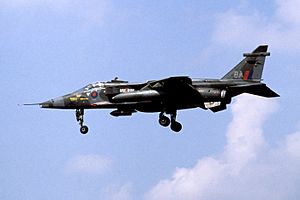
In April 1946, No. 17 Squadron went to Japan. They were part of the British forces occupying the area. The squadron stayed there until it was disbanded on February 23, 1948. But it reformed quickly on February 11, 1949, at RAF Chivenor. They took on the role of an anti-aircraft cooperation unit. They used various planes, including the Spitfire LF.XVIe and target-towing aircraft. The squadron was disbanded again on March 13, 1951.
The squadron reformed in West Germany on June 1, 1956. This time, they flew English Electric Canberra PR.7s. Their job was photo reconnaissance (taking pictures from the air). They moved to RAF Wildenrath in April 1957. The squadron was stood down on December 31, 1969. It reformed again on September 1, 1970, at RAF Brüggen. This time, they flew McDonnell Douglas Phantom FGR.2 jets for ground attack. They also had a role in nuclear deterrence, meaning they were ready to use nuclear weapons if needed to prevent a major conflict.
In September 1975, the squadron began to switch to the SEPECAT Jaguar GR.1. By January 31, 1976, they had twelve Jaguar GR.1s. These planes continued the nuclear deterrence role. Their main job was to support ground forces in a big European war. They would use regular weapons first. If the conflict got worse, they would be ready to use tactical nuclear weapons.
Still at RAF Brüggen, No. 17 Squadron started to switch to the Panavia Tornado GR.1 in January 1985. By March 1, they had twelve Tornado aircraft. These planes also had a nuclear deterrence role.
Operation Granby
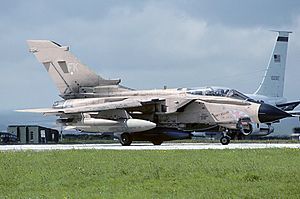
During the First Gulf War in 1991, No. 17 Squadron helped with air operations. Their Tornado GR.1s were based in Bahrain. Tornado missions began on January 17, 1991, to gain control of the skies over Iraq.
The squadron faced challenges during the war. On January 24, one of their Tornado GR.1s was damaged by an explosion. The pilot and navigator had to eject. Both crew members were captured and became prisoners of war (PoWs) until the war ended. On February 14, another Tornado GR.1 was hit by missiles. The pilot and navigator ejected. The pilot was captured, but sadly, the navigator was killed.
From Tornados to Typhoons
After the Gulf War, No. 17 Squadron returned to RAF Brüggen. They continued their nuclear deterrence role until 1998. With the end of the Cold War, the RAF decided to leave Germany. No. 17 Squadron was disbanded on March 31, 1999. This ended almost 30 years at RAF Brüggen.
The squadron reformed on September 1, 2002, as No. XVII (Reserve) Squadron. This happened at BAE Systems's Warton Aerodrome. A special facility was built there for the new Eurofighter Typhoon T.1s and F.2s. No. 17 (R) Squadron became the first RAF squadron to operate the Typhoon. Their job was to test and evaluate the new aircraft. The squadron moved to RAF Coningsby on April 1, 2005. It was officially reformed there on May 19, 2005. When the Typhoon was fully ready, the squadron's testing role ended. So, it was disbanded on April 12, 2013. Its testing duties were taken over by another squadron.
Modern Day Operations
F-35B Lightning
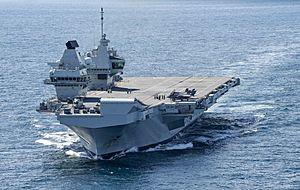
The squadron was reformed on April 12, 2013, at Edwards Air Force Base in California. It became a joint RAF and Royal Navy unit. Their mission is to test and evaluate the new Lockheed Martin F-35B Lightning jet. In January 2014, it became the first UK squadron to fly the F-35B.
In February 2015, the squadron celebrated its 100th birthday at Edwards AFB. No. 17 (R) Squadron has both RAF and Royal Navy staff. They also train people for other F-35B squadrons. The squadron has three F-35B aircraft. Their main job is to test the F-35B and its weapons. This helps bring the aircraft into service for the UK. They work with other countries like the US Air Force and US Navy. On February 1, 2018, the squadron dropped the "(Reserve)" from its name. It is now called No. 17 Test and Evaluation Squadron.
On October 13, 2019, No. 17 TES put its three F-35Bs on board HMS Queen Elizabeth. These were the first British jets to land on the aircraft carrier.
Aircraft operated
- Royal Aircraft Factory B.E.2c (Feb 1915–Nov 1915)
- Royal Aircraft Factory B.E.2c (Dec 1915–June 1918)
- Bristol Scout (July 1916–Sep 1916)
- Airco D.H.2 (July 1916–Sep 1916)
- Royal Aircraft Factory B.E.12a (Nov 1916–Sep 1918)
- SPAD S.VII (July 1917–Apr 1918)
- Nieuport 17 (Aug 1917–Dec 1917)
- Royal Aircraft Factory S.E.5a (Dec 1917–Apr 1918)
- Armstrong Whitworth F.K.8 (Mar 1918–Dec 1918)
- Airco D.H.9 (Dec 1918–Nov 1919)
- Sopwith Camel (Dec 1918–Nov 1919)
- Sopwith Snipe (Apr 1924–Mar 1926)
- Hawker Woodcock (Mar 1926–Jan 1928)
- Gloster Gamecock (Jan 1928–Sep 1928)
- Armstrong Whitworth Siskin Mk.IIIa (Sep 1928–Oct 1929)
- Bristol Bulldog Mk.II (Oct 1929–Aug 1936)
- Bristol Bulldog Mk.IIa (Oct 1929–Aug 1936)
- Hawker Hart (Oct 1935–May 1936)
- Gloster Gauntlet Mk.II (Aug 1936–June 1939)
- Hawker Hurricane Mk.I (June 1939–Feb 1941)
- Hawker Hurricane Mk.IIa (Feb 1941–Apr 1941)
- Hawker Hurricane Mk.I (Apr 1941–Aug 1941)
- Hawker Hurricane Mk.IIb (July 1941–Nov 1941)
- Hawker Hurricane Mk.IIa (Jan 1942–June 1942)
- Hawker Hurricane Mk.IIb (June 1942–Aug 1942)
- Hawker Hurricane Mk.IIc (Aug 1942–June 1944)
- Supermarine Spitfire Mk.VIII (Mar 1944–June 1945)
- Supermarine Spitfire Mk.XIVe (June 1945–Feb 1948)
- Supermarine Spitfire LF.XVIe (Feb 1949–Mar 1951)
- Airspeed Oxford T.II (Feb 1949–Mar 1951)
- Miles Martinet TT.I (Feb 1949–Jan 1950)
- North American Harvard TT.IIb (Feb 1949–Mar 1951)
- Bristol Beaufighter TT.X (June 1949–Mar 1951)
- English Electric Canberra PR.7 (June 1956–Dec 1969)
- McDonnell Douglas Phantom FGR.2 (Sep 1970–Dec 1975)
- SEPECAT Jaguar GR.1 (Sep 1975–Mar 1985)
- Panavia Tornado GR.1 (Mar 1985–Mar 1999)
- Eurofighter Typhoon T.1 (Dec 2003–Apr 2013)
- Eurofighter Typhoon F.2 (Dec 2003–Apr 2013)
- Lockheed Martin F-35B Lightning (Apr 2013–)
Images for kids
-
Hawker Hurricane Mk.IIc, similar to those flown by No. 17 Squadron, 1942 to 1944.
-
English Electric Canberra PR.7, similar to those operated by No. 17 Squadron, 1956 to 1969.
-
A pair of No. 17 (R) Squadron Eurofighter Typhoon T.1s, which were operated from 2003 to 2013.
See also
- List of Royal Air Force aircraft squadrons


